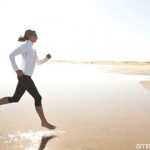Not only might I need to rethink my hydration, but also I may need to change running (and everyday) shoes. Joel Block, Najia Shakoor, and colleagues reported that at least one prototype running shoe may transmit about 8%–12% more peak knee load than flatter, more flexible shoes, specially designed shoes, sandals, or walking barefoot (Arthritis Care Res. 2010;62:917-923). This was walking (not running) patients with osteoarthritis (OA), a controlled environment, only a single measure, only a single time, and only a few shoes. There are probably much better (softer, flatter, more flexible) running and regular shoes, and what does an 8–12% load increase translate into in terms of symptoms or propensity to OA in folks with good biomechanics?
For us runners, there are issues much broader than just the knees; I now have flat feet and have learned more than I ever wanted to know about posterior tibial tendonitis; I depend on orthotics and appropriate shoes for both walking and running. I just had an enjoyable conversation with the authors of this article. They assured me that this change in load is important, that running may be different than walking, and that OA may be different than non-OA. They noted that this work is still early in its evolution.
I commend the authors for their approach and experiments. As a running enthusiast and one-time scientific/medical advisor to the bible of running, Runners World, it’s great to see genuine, serious science brought to a pastime that is suffused with myth, hyperbole, exaggeration, anecdote, hope, marketing, and belief. There are important implications in both these reports for patients (I will rethink my shoe recommendations to those with medial knee disease), as well as for the rest of us.
LESS IS MORE
I recently met with one of my incoming interns for the 2010–2011 academic year. She returned from a medical mission to Malawi earlier this year. She told me this incredibly impoverished country of 14.5 million people is served by approximately 350 physicians. The major medical center where she worked could perform no imaging studies. The only way they could perform blood chemistries was with the kits she brought with her; after her departure, there were no longer any resources to measure sodium, calcium, phosphorus, etc. Imagine, we both said almost together, how useful a country and population like this would find the things that our institution expends unnecessarily in a couple of days.


